Introduction to Emergency Management
Fourth Edition
George D. Haddow
Jane A. Bullock
Damon P. Coppola
Butterworth-Heinemann
Front-matter
Introduction to Emergency Management
Fourth Edition
Introduction to Emergency Management
Fourth Edition
George D. Haddow
Jane A. Bullock
Damon P. Coppola
 AMSTERDAM BOSTON HEIDELBERG LONDON NEW YORK OXFORD PARIS SAN DIEGO SAN FRANCISCO SINGAPORE SYDNEY TOKYO Butterworth-Heinemann is an imprint of Elsevier
AMSTERDAM BOSTON HEIDELBERG LONDON NEW YORK OXFORD PARIS SAN DIEGO SAN FRANCISCO SINGAPORE SYDNEY TOKYO Butterworth-Heinemann is an imprint of Elsevier 
Copyright
Acquiring Editor: Pamela Chester
Development Editor: Gregory Chalson
Project Manager: Julie Ochs
Designer: Alisa Andreola
Butterworth-Heinemann is an imprint of Elsevier
30 Corporate Drive, Suite 400, Burlington, MA 01803, USA
2011 Elsevier, Inc. All rights reserved.
No part of this publication may be reproduced or transmitted in any form or by any means, electronic or mechanical, including photocopying, recording, or any information storage and retrieval system, without permission in writing from the publisher. Details on how to seek permission, further information about the Publisher's permissions policies and our arrangements with organizations such as the Copyright Clearance Center and the Copyright Licensing Agency, can be found at our website: www.elsevier.com/permissions.
This book and the individual contributions contained in it are protected under copyright by the Publisher (other than as may be noted herein).
Notices
Knowledge and best practice in this field are constantly changing. As new research and experience broaden our understanding, changes in research methods or professional practices, may become necessary. Practitioners and researchers must always rely on their own experience and knowledge in evaluating and using any information or methods described herein. In using such information or methods they should be mindful of their own safety and the safety of others, including parties for whom they have a professional responsibility.
To the fullest extent of the law, neither the Publisher nor the authors, contributors, or editors, assume any liability for any injury and/or damage to persons or property as a matter of products liability, negligence or otherwise, or from any use or operation of any methods, products, instructions, or ideas contained in the material herein.
Library of Congress Cataloging-in-Publication Data
Haddow, George D.
Introduction to emergency management/George D. Haddow, Jane A. Bullock, Damon P. Coppola. 4th ed.
p. cm.
Includes bibliographical references and index.
ISBN 978-1-85617-959-1 (hardcover : alk. paper) 1. Emergency management. 2. Emergency managementUnited States. 3. Communication in management. I. Bullock, Jane A. II. Coppola, Damon P. III. Title.
HV551.2.H3 2010
363.3480973dc22
2010014614
British Library Cataloguing-in-Publication Data
A catalogue record for this book is available from the British Library.
ISBN: 978-1-85617-959-1
Printed in the United States of America
10 11 12 13 14 10 9 8 7 6 5 4 3 2 1

For information on all BH publications visit our website at www.elsevierdirect.com/security
Dedication
This book is dedicated to Lacy Suiter. Lacy taught us all the responsibility, privilege, and honor of serving people as emergency managers. He singlehandedly made emergency management an important discipline to the safety of our citizens. He was a gentleman, a mentor, a teacher, a cheerleader, and an impromptu singer, but most of all, he was the best friend anyone could ever have.
Foreword
James Lee Witt
James Lee Witt Associates
In 1993, when I took over leadership of the Federal Emergency Management Agency (, to work with our state, local, and private partners to build one of the most respected emergency management systems in the world.
As the tragic outcome of Hurricane Katrina so vividly demonstrated, a strong emergency management system is vital to the safety of all of our citizens. There is no time in our recent history when the need for and understanding of the discipline of emergency management have been more important. The current risk environment we live in, from potential bioterrorist threats, increasingly severe hurricanes and floods, and more frequent wildfires, has dramatically increased the skills and knowledge required to be an effective emergency manager in today's world.
Introduction to Emergency Management is the authoritative guide on today's discipline of emergency management. It takes the reader through the historical context of emergency management to the present day evolution into the world of homeland security. This book focuses on the elements of an emergency management process while providing the policy underpinnings that support that process. It provides a comprehensive case study that examines the events and issues surrounding Hurricane Katrina. While focusing on the current changes happening to the United States system for emergency management, it provides readers with a solid background in international practices and policies for disaster management/homeland security. This book gives the reader practical, real world experiences through documented case studies and provides extensive references and Internet sites for follow up research.
My philosophy about emergency management has always been that we need to take a common-sense, practical approach to reducing the risks we face and protecting our citizens and our communities. We need to identify our risks, educate and communicate to our people about those risks, prepare as best we can for the risks, and then, together, form partnerships to take action to reduce those risks. This approach applies whether we are dealing with a flood, a tornado, a hazardous materials spill, a wildfire, a potential suicide bomb explosion, or a pandemic flu outbreak. George Haddow and Jane Bullock were my Deputy Chief of Staff and my Chief of Staff, respectively, when I was Director of, . Together we worked to apply this approach to making our citizens and communities more disaster resistant and safer throughout the world. As you read and learn from this book, I hope you will keep those ideals in mind.
Acknowledgments
This book could not have been completed without the assistance of a series of valuable partners. We would like to thank Wayne Blanchard, whose vision, encouragement, and insights on effective education in emergency management have improved our work and the work of emergency managers everywhere. We are also grateful to the Institute for Crisis, Disaster, and Risk Management at The George Washington University, and its codirectors, Dr. Jack Harrald and Dr. Joseph Barbera, for their support. Greg Shaw's humor helped us to keep things in perspective.
We thank the many professors, students, and practitioners who gave us valuable feedback on different aspects of the book and provided suggestions to make the text more relevant and useful.
Finally, the authors wish to thank their respective spouses, Kim Haddow and Mary Gardner Coppola, for their enduring good humor and patience.



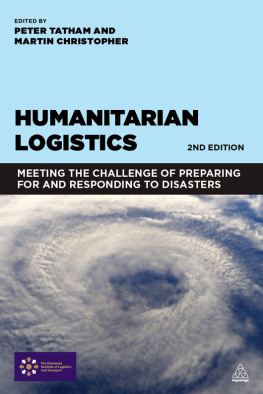
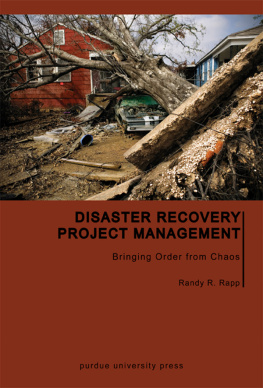
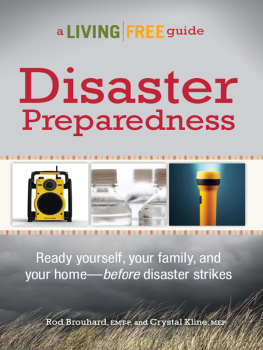
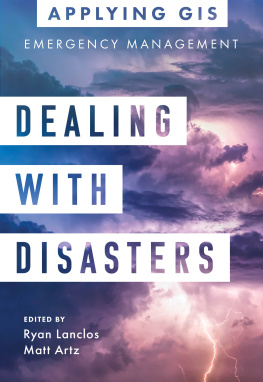

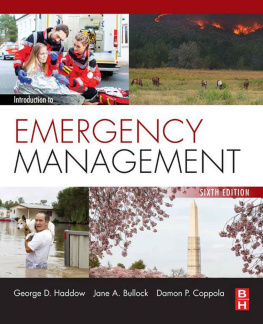
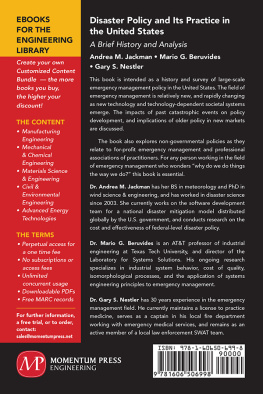
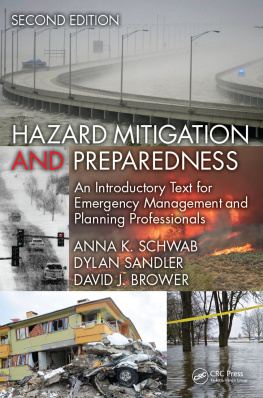
 AMSTERDAM BOSTON HEIDELBERG LONDON NEW YORK OXFORD PARIS SAN DIEGO SAN FRANCISCO SINGAPORE SYDNEY TOKYO Butterworth-Heinemann is an imprint of Elsevier
AMSTERDAM BOSTON HEIDELBERG LONDON NEW YORK OXFORD PARIS SAN DIEGO SAN FRANCISCO SINGAPORE SYDNEY TOKYO Butterworth-Heinemann is an imprint of Elsevier 
